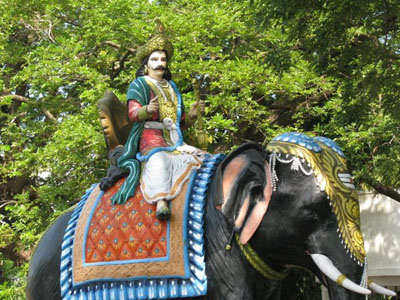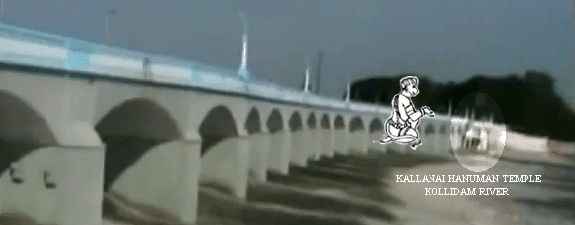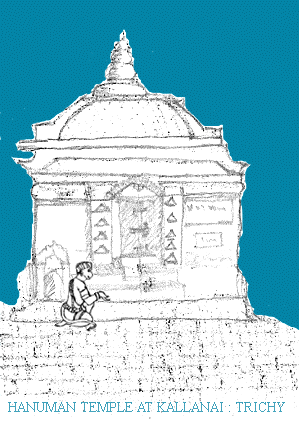
The river Kaveri
The river Jeevanadhi Kaveri originates from the Bramahagiri Hills in Kodagu, Karnataka. The place where the river originates is known as Tala Kaveri which is at a height of 4400 feet above MSL. After traveling around three hundred eighty-five KM the river reaches Tamil Nadu at Hogenakkal near Mettur.
From Hogenakkal up to Bhavani the river runs southwards. The river Bhavani which originates at about 800 feet MSL southwest of Otty in Nelgiri hill range amalgamates with Kaveri at the place called Bhavani. From there the course of the river is eastward and Noyyal and Amaravati rivers also amalgamate with Kaveri. She becomes broader and the flow of the river is so majestic that the sight of it will make one spellbound.
Kaveri and Kollidam
The river swells so broad that it splits into two streams just west of Trichy near Elananur. The northern stream is named Kollidam and the southern stream retains the name Kaveri. The rivers try to rejoin again near Kallanai thus forming an island in between. The formed island is where the famous Sri Rangam and Tiruvanaikaval are situated. However, these two rivers were not able to amalgamate since Kollidam flows in a lower plain than Kaveri. The rivers are running side by side at this point and hence whenever there are floods, the river Kaveri will breach its northern bank and the excess water will flow through Kollidam. It required an annual routine to rebuild the northern bank of Kaveri for proper irrigation.
The scenario changed when King Karikala Chola of the great Chola dynasty built a dam across this broad and majestic river to control the flow of the river so that water for irrigation is properly managed.
Dam of unhewn stone
During the reign of Karikala Chola, a plan was conceived to prevent the recurrence of this breach of the banks of the river. Karikala Chola selected the right spot where the dam should be built to enable the regulation of water flow. This place is today known by the dam itself as ‘Kallanai’. It is still a wonder that the king had constructed a dam just with stones stacked with sand as the base and no mortar was used. The technology adopted by Karikala Chola two thousand years ago is amazing and considered to be an astonishing engineering feat even by modern-day engineers.
Grand Anicut
Thus built with unhewn stone by Karikala Chola, the massive 329 m (1,079 ft) long and 20 m (66 ft) wide Kallanai had withstood the test of time, vagaries of nature for nearly two thousand years and is the first man-made dam on the earth. Later during the British Raj regulators for the flow of water in the rivers Kaveri and Kollidam were designed and executed over the Karikala Chola’s Kallanai itself. The British were so amazed that they called Kallanai ‘Grand Anicut’.
Karikala Chola
 The man behind this feat is Karikala Chola or Karikala Chozhan (Tamil: கரிகால சோழன்)
was the king of Early Chola during the Sangam period. He was the son of Ilamcetcenni
and ruled around 270 BC. He was also known by the epithets Karikala Peruvalathaan
(கரிகால பெருவளத்தான்) and Thirumavalavan (திருமாவளவன்).
The man behind this feat is Karikala Chola or Karikala Chozhan (Tamil: கரிகால சோழன்)
was the king of Early Chola during the Sangam period. He was the son of Ilamcetcenni
and ruled around 270 BC. He was also known by the epithets Karikala Peruvalathaan
(கரிகால பெருவளத்தான்) and Thirumavalavan (திருமாவளவன்).
The name Karikala has been held to mean 'the man with the charred leg' and perpetuates the memory of a fire accident in the early years of his life.
The Chola king Ilancetcenni with Urayur as capital through his wife Velir princess from Azhundur had a son. Soon after the birth of the son the king died. Since the prince was too young, he was overlooked for the position of king. There was political turmoil in the kingdom. At one stage the place where the prince was staying was set on fire. But the prince escaped the fire and, with the help of his uncle Irum-pitar-thalaiyan, defeated his enemies to become the king. During this incident, the leg of the prince was scorched in the fire and hence he is known as ‘Karikallan’ meaning ‘the man with the charred leg’.
Kallanai and British
Thanjavur delta was the rice bowl of the south and catered to the needs of South India, Ceylon, and also Burma all of which were under the British then. British called this delta land the Fertile Crescent in their empire, giving three harvests of rice a year. The same is the reason that the British have invested a lot in expanding the river to increase their revenue. The first thing that attracted them was the point from which the Kaveri water flows into this delta area i.e., Kallanai. They took all steps to construct water regulation sluices at this place which will enable them to keep the delta fertile. There were many developments and designs of sluices in Kallanai across the Kollidam River and Kaveri River during the British right through the 19th and early 20th centuries. Captain Calddell, Sir Arthur Cotton Engineer in charge of Madras province, and Mr. W.M.Ellis, CIE, RE were few who had helped build sluices here.
Structures built by British
Today the original ‘Kallanai’ immortalised by Karikala Chola is visible only during summer when the river is dry. British had built sluices [நீரொழுங்கி] and bridges [மதகு] over them and today we could see Kallanai along with these structures only. There is a wonderful structure that these British were asked to build on Kallanai, which you may miss if you are not aware. The structure is a temple for Sri Anjaneya Swami. The temple is on the Kollidam River regulator side.
Regulators across Kollidam
Right on the dike built by Karikallan across the Kollidam River, the British wanted to build water regulating gates and a bridge. Captain J.L.Calddell was in charge of the project during that time. The work progressed well but when they took up construction of the 19th vent they could not complete the same. They had tried several times to finish but could not. It was a mystery to the officer in charge of the site who had to spend sleepless nights.
Every season before the water is released for cultivation of the first ‘bogam’, the paddy seeds are first offered to the Lord then to the river and then the water for irrigation is released from all sluices. Farmers, Engineers, and Ministers used to participate in this pooja ceremony.
British Captain and Sri Anjaneya
The engineer in charge Captain J.L.Calddell one night had a strange dream in which Sri Anjaneya appeared and persuaded him to build a temple for Him at that spot. The British were not prepared to believe this and continued trying to rebuild the 19th vent but in vain. He did not share his dream with anybody, but in a few days, a group of monkeys flocked to him reminding him about Sri Anjaneya. Captain was not moved and remained stubborn. But the next day a mestiri [mason in charge] reported to the Captain stating that he had a dream in which Sri Anjaneya told him that a temple should be built at the spot for Him. Captain was taken aback to hear the description given by the mestiri and changed his mind. He then allowed the temple for Sri Anjaneya to be constructed, at the very same spot as was directed by Sri Anjaneya in the dream.
There is a stone, in one corner of the temple as a record of this fact with a note “Repaired this colling LHA & Erected the 26s upright stones by Cap. J.L.Calddel AD 1804”. Below this, there is a note in Tamil stating that the stone is erected as per the orders of the Government. On the other side of the stone, Sri Hanuman’s figure had been engraved [as we see in temple pillars].
Sri Hanuman Protector of Kallanai
 It is more than two hundred years that Lord Sri Hanuman has been protecting this two
thousand years old bridge. It is widely believed that He is the Protector of the
two-thousand-year-old Kallanai and the Master who irrigates the Thanjavur delta.
Every year before the water is released for the cultivation of paddy to the delta,
poojas are conducted in this temple. Every season before the water is released for
cultivation of the first ‘bogam’, the paddy seeds are first offered to the
Lord then to the river and then the water for irrigation is released from all
sluices. Farmers, Engineers, and Ministers used to participate in this pooja
ceremony.
It is more than two hundred years that Lord Sri Hanuman has been protecting this two
thousand years old bridge. It is widely believed that He is the Protector of the
two-thousand-year-old Kallanai and the Master who irrigates the Thanjavur delta.
Every year before the water is released for the cultivation of paddy to the delta,
poojas are conducted in this temple. Every season before the water is released for
cultivation of the first ‘bogam’, the paddy seeds are first offered to the
Lord then to the river and then the water for irrigation is released from all
sluices. Farmers, Engineers, and Ministers used to participate in this pooja
ceremony.
Poojas are conducted in the other three temples around, namely Sri Vinayaka, Sri Kaliamman, and Sri Karuppannachami at that time.
A very strange spot for a temple
 Sri Anjaneya had selected this very strange spot to stay. During early January 2008
when I visited the temple, ankle-deep water was flowing on the floor of the front
hall. I was told that during the season when water is released in Kollidam the
basement of the temple and the floor of the front hall will not be visible. Water
will be flowing up to the brim of the doorsteps of the temple. A sight which is
beyond imagination, the pundit tells it is seen to be believed. It is a unique spot
for a temple, but Lord Hanuman had selected this spot for Himself for the reason
best known to Him.
Sri Anjaneya had selected this very strange spot to stay. During early January 2008
when I visited the temple, ankle-deep water was flowing on the floor of the front
hall. I was told that during the season when water is released in Kollidam the
basement of the temple and the floor of the front hall will not be visible. Water
will be flowing up to the brim of the doorsteps of the temple. A sight which is
beyond imagination, the pundit tells it is seen to be believed. It is a unique spot
for a temple, but Lord Hanuman had selected this spot for Himself for the reason
best known to Him.
The Temple is facing east, with a big hall in front. The temple is about ten feet by ten feet. The main garbhagraham constitutes the entire temple. There is a two feet wide open prakaram around the temple with closely placed iron grills around, it to prevent any untoward incident like devotees falling into the river, etc.
[About the drawing of the temple: The drawing of the temple which I had drawn here is from the front of the temple from the hall. The gopuram of the temple had been drawn as I had seen from the steps that lead to the temple. I had put them together in this drawing, as the temple would be visible when the front hall is not there.]
Sri Jaya Veera Anjaneya
Sri Hanuman of this temple is facing north in an ardha shila form. Lord is seen moving towards the north. Sri Hanuman is holding the ‘sowgandhika’ flower in His left hand which is resting on the hip. Lord’s right hand is seen raised above His shoulder with ‘abhaya mudra’. Lord’s tail is seen raised above His head, with a small bell tied at the end. Lord is wearing three malas on his neck. His kesam is seen tied neatly and tagged. Lord's eyes are radiant and glowing mesmerising the devotee and making him spellbound.
The daily poojas are done as per the Madwa tradition.
Location of the temple: "Sri Anjaneya Temple at Kallanai, TN"
Experience
Come and see the Lord who has been protecting the two-thousand-year-old Kallanai for the last two hundred years standing in a unique spot. A Marvel! He is the protector of one and all, surrender yourself and see what all He bestows on you.
SRI HANUMAN THINKS DIFFERENTLY, THINKS FAST
THINKS AHEAD AND ACTS FOR SURE
Ed [December 2011] Sri Hanumath Jayanti Special
Updates: [Jan
2025]
